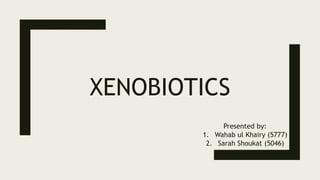Presentation.pptx
•Download as PPTX, PDF•
0 likes•3 views
XENobiotics introduction for self study.
Report
Share
Report
Share

Recommended
Recommended
More Related Content
Similar to Presentation.pptx
Similar to Presentation.pptx (20)
Risk Analysis and Environmental Health HazardsChapter 4.docx

Risk Analysis and Environmental Health HazardsChapter 4.docx
Recently uploaded
In recent years, the growth of scientific data and the increasing need for data sharing and collaboration in the field of environmental chemistry has led to the creation of various software and databases that facilitate research and development into the safety and toxicity of chemicals. The US-EPA Center for Computational Toxicology and Exposure has been developing software and databases that serve the chemistry community for many years. This presentation will focus on several web-based software applications which have been developed at the USEPA and made available to the community. While the primary software application from the Center is the CompTox Chemicals Dashboard almost a dozen proof-of-concept applications have been built serving various capabilities. The publicly accessible Cheminformatics Modules (https://www.epa.gov/chemicalresearch/cheminformatics) provides access to six individual modules to allow for hazard comparison for sets of chemicals, structure-substructure-similarity searching, structure alerts and batch QSAR prediction of both physicochemical and toxicity endpoints. A number of other applications in development include a chemical transformations database (ChET) and a database of analytical methods and open mass spectral data (AMOS). Each of these depends on the underlying DSSTox chemicals database, a rich source of chemistry data for over 1.2 million chemical substances. I will provide an overview of all tools in development and the integrated nature of the applications based on the underlying chemistry data. This abstract does not necessarily represent the views or policies of the U.S. Environmental Protection Agency.Chemistry Data Delivery from the US-EPA Center for Computational Toxicology a...

Chemistry Data Delivery from the US-EPA Center for Computational Toxicology a...US Environmental Protection Agency (EPA), Center for Computational Toxicology and Exposure
Recently uploaded (20)
Vital Signs of Animals Presentation By Aftab Ahmed Rahimoon

Vital Signs of Animals Presentation By Aftab Ahmed Rahimoon
Factor Causing low production and physiology of mamary Gland

Factor Causing low production and physiology of mamary Gland
Chemistry Data Delivery from the US-EPA Center for Computational Toxicology a...

Chemistry Data Delivery from the US-EPA Center for Computational Toxicology a...
Adaptive Restore algorithm & importance Monte Carlo

Adaptive Restore algorithm & importance Monte Carlo
MSC IV_Forensic medicine - Mechanical injuries.pdf

MSC IV_Forensic medicine - Mechanical injuries.pdf
Mining Activity and Investment Opportunity in Myanmar.pptx

Mining Activity and Investment Opportunity in Myanmar.pptx
Classification of Kerogen, Perspective on palynofacies in depositional envi...

Classification of Kerogen, Perspective on palynofacies in depositional envi...
Costs to heap leach gold ore tailings in Karamoja region of Uganda

Costs to heap leach gold ore tailings in Karamoja region of Uganda
Fun for mover student's book- English book for teaching.pdf

Fun for mover student's book- English book for teaching.pdf
ANITINUTRITION FACTOR GYLCOSIDES SAPONINS CYANODENS

ANITINUTRITION FACTOR GYLCOSIDES SAPONINS CYANODENS
SaffronCrocusGenomicsThessalonikiOnlineMay2024TalkOnline.pptx

SaffronCrocusGenomicsThessalonikiOnlineMay2024TalkOnline.pptx
POST TRANSCRIPTIONAL GENE SILENCING-AN INTRODUCTION.pptx

POST TRANSCRIPTIONAL GENE SILENCING-AN INTRODUCTION.pptx
Presentation.pptx
- 1. XENOBIOTICS Presented by: 1. Wahab ul Khairy (5777) 2. Sarah Shoukat (5046)
- 2. Introduction ■ Xenobiotic is a term used to describe chemical substances that are foreign to animal life. ■ Examples as plant constituents, drugs, pesticides, cosmetics, flavorings, fragrances, food additives, industrial chemicals and environmental pollutants. ■ Xenobiotic means ‘foreign to life’. ■ It can also cover the substances in which are present in higher concentrations than usual in any product. ■ It’s not normally naturally produced.
- 3. Origin ■ Some organisms may also form them as a part of their defense system, ■ Examples; mycotoxins, bacterial and herbal toxins, etc. ■ Xenobiotics become harmful when entering the food chain. ■ Contemporary human exposure to xenobiotics is unavoidable, as they are omnipresent. ■ Term xenobiotic is derived from the Greek words ξένος (xenos) = foreigner, stranger and βίος (bios) = life. ■ Xenobiotics may be grouped as carcinogens, drugs, environmental pollutants, food additives, hydrocarbons, and pesticides.
- 4. Purpose ■ Xenobiotic metabolism functions primarily to increase the polarity of xenobiotics, making them easier to excrete. ■ With passive transport, molecules cross biological membranes without the consumption of chemical energy.
- 5. Types ■ Environmental pollutants, ■ Hydrocarbons, ■ Food additives, ■ Oil mixtures, ■ Pesticides, ■ Synthetic polymers, ■ Carcinogens, drugs, and antioxidants are the major groups of xenobiotics
- 6. The role of xenobiotics in human health: ■ XENobiotics may alter the microbiota composition, leading to a state of dysbiosis, which is linked to multiple diseases and adverse health outcomes, including increased toxicity of some xenobiotics.
- 7. Sources ■ Ambient environment : Learn about the various sources of xenbiotics present in our surrounding including Air pollutants, water Contaminants and soil contaminants. ■ Dietary Exposure: Explore how Xenbiotics can enter into the human body through the contaminated food. ■ Occupational exposure: Discover the Potential risks of Xenbiotics exposure in specific environment , such as Factories, laboratories and agriculture fields.
- 8. Effect on human Health ■ Acute Toxicity: Understand the immediate and severe harmful effects xenobiotics can have on human health, ranging from poisoning to organ damage. ■ Chronic Diseases: Explore how long-term exposure to xenobiotics can contribute to the development of chronic diseases, including cancer, neurological disorders, and respiratory conditions. ■ Reproductive health: Discover the impact of xenobiotics on reproductive health, including fertility issues, developmental abnormalities in offspring, and hormonal disruptions.
- 9. Metabolism of Xenobiotics ■ Phase I Reactions: Learn how xenobiotics are metabolized through oxidation, reduction, and hydrolysis reactions to generate reactive intermediates. ■ Phase II Reactions: Explore the conjugation processes where reactive intermediates are combined with molecules like glutathione and glucuronic acid to facilitate their elimination. ■ Role of Enzymes: Discover the crucial role of enzymes, such as cytochrome P450 and UDP-glucuronosyltransferase, in metabolizing and biotransforming xenobiotics.